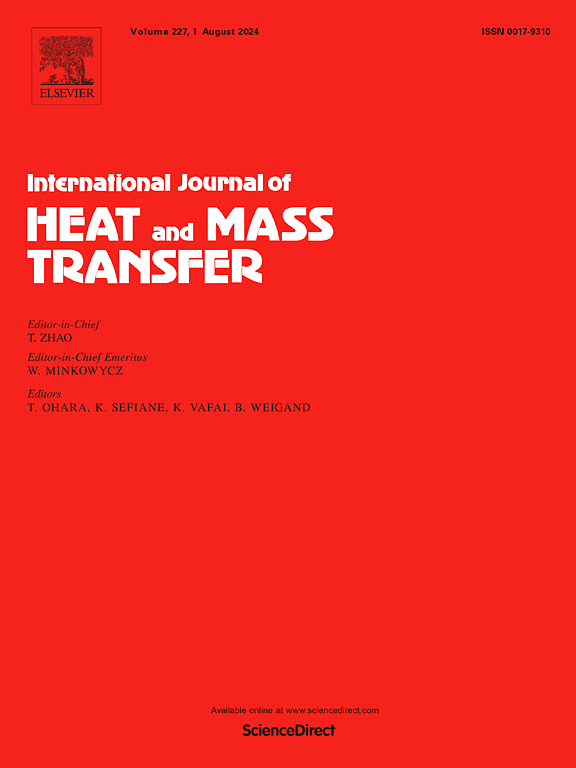Melting and solidification performance of latent heat thermal energy storage system under flip condition
IF 5
2区 工程技术
Q1 ENGINEERING, MECHANICAL
International Journal of Heat and Mass Transfer
Pub Date : 2024-10-29
DOI:10.1016/j.ijheatmasstransfer.2024.126370
引用次数: 0
Abstract
Latent heat storage technology has made significant contributions to solving the problem of unstable renewable energy supply. Related research indicates that phase change devices are essential for the stability of spacecraft temperature control systems. However, phase change material (PCM) has low thermal conductivity, which reduces device thermal storage and release efficiency. Moreover, the PCM heat transfer performance is further affected by movements such as attitude adjustment during the launch and operation of spacecraft. This paper adopted active heat transfer enhancement technology to enhance uniformity and rate of heat transfer in latent heat thermal energy storage (LHTES) unit. A new method is presented on flipping LHTES unit at appropriate stages of the phase change process, namely flipping enhancement technology. This method effectively uses the benefits of natural convection to enhance heat transfer, reducing the storage and release time of LHTES systems. A physical model was established building upon verification with data in literature, and the effect of flipping under different phase transition fractions on melting and solidification performance within the square cavity was discussed through numerical simulation. Further analysis was conducted on factors including phase transition fraction, phase interface, temperature interface distribution, velocity interface distribution, and heat storage capacity. Finally, the response surface methodology (RSM) was adopted to analyze and determine the optimal flipping phase transition fraction. The research results indicate that flipping improves the heat transfer efficiency of LHTES. Flipping significantly enhances heat transfer 3–5 times during melting compared to solidification process. As the phase transition fraction increases, the complete melting/solidification time demonstrates a trend of decline followed by an increase. Through single factor analysis, the optimal flipping liquid fraction is 51.65 % during the melting process, leading to a substantial decrease in complete melting time by 25.71 %. Based on this, the optimal phase transition fraction combination of melting first and then solidification was explored, which shortened the melting-solidification full cycle time by 12.96 %. This study investigates the melting/solidification performance of LHTES unit under flip conditions, which guides the design of phase change thermal control devices and contributes to the field of spacecraft thermal management.
翻转条件下潜热蓄热系统的熔化和凝固性能
潜热储存技术为解决不稳定的可再生能源供应问题做出了重大贡献。相关研究表明,相变装置对航天器温度控制系统的稳定性至关重要。然而,相变材料(PCM)的热传导率较低,从而降低了设备的热存储和释放效率。此外,航天器发射和运行过程中的姿态调整等运动也会进一步影响 PCM 的传热性能。本文采用主动传热增强技术来提高潜热蓄热装置的传热均匀性和传热速率。本文提出了一种在相变过程的适当阶段翻转潜热蓄热装置的新方法,即翻转增强技术。这种方法能有效利用自然对流的优势来增强热传递,从而缩短潜热蓄热系统的储存和释放时间。在验证文献数据的基础上建立了物理模型,并通过数值模拟讨论了不同相变分数下的翻转对方形空腔内熔化和凝固性能的影响。对相变分数、相界面、温度界面分布、速度界面分布和蓄热能力等因素进行了进一步分析。最后,采用响应面方法(RSM)分析并确定了最佳翻转相变分数。研究结果表明,翻转提高了 LHTES 的传热效率。与凝固过程相比,翻转可将熔化过程中的传热效率提高 3-5 倍。随着相变分数的增加,完全熔化/凝固时间呈现先下降后上升的趋势。通过单因素分析,熔化过程中的最佳翻转液体分数为 51.65%,从而使完全熔化时间大幅减少 25.71%。在此基础上,探讨了先熔化后凝固的最佳相变分数组合,使熔化-凝固全周期时间缩短了 12.96%。这项研究探讨了 LHTES 单元在翻转条件下的熔化/凝固性能,为相变热控制装置的设计提供了指导,并为航天器热管理领域做出了贡献。
本文章由计算机程序翻译,如有差异,请以英文原文为准。
求助全文
约1分钟内获得全文
求助全文
来源期刊
CiteScore
10.30
自引率
13.50%
发文量
1319
审稿时长
41 days
期刊介绍:
International Journal of Heat and Mass Transfer is the vehicle for the exchange of basic ideas in heat and mass transfer between research workers and engineers throughout the world. It focuses on both analytical and experimental research, with an emphasis on contributions which increase the basic understanding of transfer processes and their application to engineering problems.
Topics include:
-New methods of measuring and/or correlating transport-property data
-Energy engineering
-Environmental applications of heat and/or mass transfer

 求助内容:
求助内容: 应助结果提醒方式:
应助结果提醒方式:


